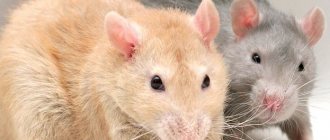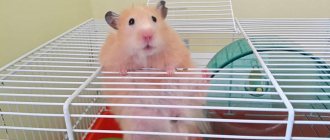Temperature fluctuations, daylight hours - all this affects rodents. Once you find the motionless body of your beloved homa in a cage, you shouldn’t immediately get scared. Few people know that hamsters, even living at home, can sometimes fall into stupor. This is not a seasonal long hibernation, like that of a bear. A hamster physiologically cannot accumulate enough nutrients in its body to fall into a sweet, carefree sleep for several months. This could be fatal for him.
With this article we want to help the owner of a tame hamster, so as not to “break the woods” in the situation that has arisen, or to mistakenly bury a sleeping pet.
Habitual sleep pattern
At its core, the hamster is a nocturnal animal, both at home and in nature. At night he is awake, and during the day he sleeps.
An animal can easily sleep all day, but when night comes, he will begin to actively spin the wheel, climb in mazes and restore order in the cage. Many owners of a cute animal are not happy with this, so they try to teach it to sleep at night.
This is very difficult to do. In addition, if the owner does not allow the pet to sleep during the day, this will unsettle him. Therefore, it is better not to interfere with his usual sleep pattern.
Sleeping or dead?
This is not difficult to determine. The main thing is to be patient.
- In a state of torpor, the hamster’s body, although cold, hard and motionless, can still hear its heartbeat. It is rare - only a few beats per minute.
- The animal also occasionally continues to inhale and exhale. Hold a mirror to its muzzle: if the hamster is alive, after some time traces of fogging will appear on the glass from its breathing.
What is numbness?
What is this numbness like?
This is a physiological condition that is common in some small mammals. During torpor, metabolism drops to a minimum, and the body goes into economy mode. Because of this, the animals become inactive and remain in a state of bodily rigor. They have virtually no reaction to external stimuli.
Help: sleepy torpor does not occur at a certain time of the year, as during hibernation, but at a certain time of the day when the animal is not active.
Symptoms of torpor in hamsters
The condition can be determined by the following symptoms:
- the heart beats less often, it can be difficult to hear and feel its beats;
- the body cools down;
- the muscles become stiff.
In other words, it appears that the hamster has died.
Duration
The rodent can remain in this state from several hours to several days. The duration of torpor depends on external factors and the comfort of the hamster's standard of living.
This is interesting: in the wild, a hamster can fall into a state of torpor just because it came out of its burrow on a winter night. If at home he is cold throughout the day, then the body will also begin to save energy.
Do you monitor the temperature in the room where the rodent is kept?
Factors contributing to torpor in hamsters at home
Factors that can cause an animal to fall into a sleepy stupor:
- Cold - in this case, the animal triggers the same instinct as in wild hamsters - the body switches to economy mode. If the room temperature is less than 10 degrees Celsius, then this condition cannot be avoided. The temperature in the room should be at least 15 degrees Celsius.
- Darkness - you should not place the cage in a very dark place, as well as in an excessively light one. The animal accepts the darkness as a short daylight hours, so it goes to sleep.
- Improper nutrition - if an animal is malnourished or lacks vitamins and minerals, then its activity is greatly reduced. In order for energy resources to be consumed more slowly, the body starts saving mode.
- Stress - due to severe shocks, the hamster may fall into stupor in order to recover from the shock experienced.
- Fear can be swimming, a sudden attack by a cat, falling from a height, or any sharp sound.
This is interesting: the owner’s untimely desire to play with it can cause stress in the animal. If you constantly wake up a rodent during sleep, it will become very irritable and aggressive, or even go into hibernation.
Is it worth waking up a torpid hamster?
There is no clear answer to this question. A decision must be made based on the situation.
Some experts argue that you should not interfere with the life processes in the animal’s body so as not to harm it. In the wild, the hamster prepares for a long sleep, so it eats up the subcutaneous fat layer so that it has something to eat during hibernation.
In addition, according to facts, those hamsters that sleep for a long time in winter live much longer than those that are awake. Only winter sleep has a bad effect on future offspring - children are born less often and in smaller numbers.
If the owner decides not to wake up the pet, then he needs to make sure that the rodent wakes up in comfortable conditions. It is recommended to insulate the cage, put more cotton wool in it, and carefully move the pet into it. You need to put a lot of healthy food in the feeder so that after waking up the hamster has something to eat
Is there any point in waking him up?
There are those who argue that a hamster that lives at home has absolutely no need to hibernate. Therefore, it is better to wake him up so as not to disrupt his further rhythm of life. In this case, the owner needs to correct the error in care so that his pet no longer falls into torpor.
It is also necessary to wake up the rodent if it has not eaten the fat layer, but has fallen into “emergency torpor” in order to avoid dehydration and exhaustion of the body. If he is not awakened, he may die of starvation.
All breeds are dormouse!
The most popular types of hamsters for home breeding include:
- Syrian;
- Djungarian;
- long-tailed;
- ordinary;
- angora.
Albino.
There are also so-called albino hamsters. These are also very often kept at home. Although this is not a breed, it is a biological feature of a living organism - the absence of dark pigmentation. These hamsters are pure white with a pink nose and pink eyes. All these hamsters are capable of falling into suspended animation, since this was typical for their ancestors under natural conditions. By the way, it has been noticed that most often hibernation at home “happens” to Syrian hamsters.
How to wake up a hamster?
To awaken the hamster, it is necessary to create conditions opposite to those that caused the rodent to go into torpor. The cage needs to be moved to a warmer and brighter place, where the air temperature will not be lower than 20-22 degrees Celsius.
You can put his favorite treats next to the spout, wrap it in a warm cloth and put more food in the bowl.
After waking up, the animal will not be active. At first he will be very lethargic. It is necessary to wait until all its life processes resume.
It is prohibited to warm up a rodent using radiators or electric heaters. This may harm him or lead to death.
The rhythm of life of wild animals
Once again, to understand the life cycles of hamsters, let's turn to the wild. All new owners are concerned about the question: do hamsters hibernate? And what kind of life do they generally lead?
Hibernation
The rhythm of life of wild rodents is quite simple: in the warm season, crunchies fill their cheeks and carry reserves in them to their burrow. They are preparing for unfavorable conditions - lower temperatures and lack of food in the meadows and vegetable gardens.
When the average daily temperature outside drops and the day becomes very short, the homa understands that it is time to get some sleep. After all, maintaining body temperature at a constant level during cold weather requires a large amount of food. But the hamster is an economical animal. If he eats up his reserves while trying to stay awake, he won’t survive the winter. Therefore, the homa goes into a hole, makes a nest of dry leaves and falls asleep not far from the pantry.
A sleeping hamster begins to breathe less frequently, its heartbeat also slows down, and its metabolism seems to adjust to an economical mode. At the same time, his body temperature becomes lower by 1-2ºС, which also saves energy resources for heating. The body is nourished during hibernation by the fat layer that the crunch has gained over the summer. Periodically, the homa wakes up, snacks on supplies and falls into torpor again.
With the spring temperature rise, rodents come out of their stupor and continue to eat up reserves, because there are still a couple of months before fresh food ripens.
Daytime nap
People don't often see hamsters in the wild because they are nocturnal animals. Khoma has no time to sleep at night, because under the cover of darkness he obtains supplies. Darkness is his faithful protector from predators and gardeners trying to catch the animal.
Tired during a working night, after dawn the homa hides in its hole, has a snack and goes to bed until the next evening. Likewise, the domestic hamster sleeps when people are active, and wakes up in the evening.
Walk
When you see a hamster gnawing doomedly at the bars of its cage, does your heart clench with pity? Do you feel that your hamster needs freedom, so every evening you let him out for a walk and watch with affection as he gets stuck under the closet or falls from the curtain? Whether or not to let your hamster out for a walk is up to you, but the best thing you can do is buy a ball for walking or fence off a safe area with enclosures. Believe me, there is no hole that a hamster cannot fit through. Although it seems to you that your pet is a fat, overfed hog, in fact, at the right time he can become very flat, so it is better not to let him roam freely. Otherwise, you risk finding it on the cabinet, in a pot of fish, or, God forbid, in your underwear drawer. Yes, a hamster can do it.
Is there any point in waking him up?
Knowing now how a hamster hibernates and for what reasons, the next question immediately arises: what to do in such a situation and whether it is necessary to push the animal so that it comes to its senses. Experts recommend that if a rodent has fallen into torpor before winter and has not gained any fat before that, then the rodent must be awakened, since then it will die from exhaustion and dehydration.
But, if everything is fine, and you see this in your animal, and he has gained fat, it is better not to touch him, he will wake up on his own.
How to wake up a hamster
Once you realize that your pet is in a state of torpor, in order to wake him up, he must be placed in a warm place. Under no circumstances should you place your hamster near a fire, on a radiator, or on a heater.
One of the best ways is to hold the rodent in your arms and breathe on it, thus warming it up. Slowly the animal will tremble and move, and after 30-60 minutes the hamster will come to its senses.
Hamsters don’t experience such torpor; they just fall asleep for a while. The most important thing is not to confuse this moment with the death of an animal. It is not necessary for pet rodents to go into torpor. Dzhungarika torpor most often appears in winter, and much depends on the conditions of their detention. Most often, domestic animals do not have this state of torpor.
Recommended sequence of actions and process features
So, in addition to running water, soda and citric acid, we will need a thin brush or a strong fishing line with a soft, lint-free rag. If you follow all the recommendations correctly, the desired result can be achieved without much hassle in a quarter of an hour. To clean the hookah, you must perform the following manipulations:
- Remove the foil from the hookah bowl and remove all remaining tobacco mixture. It is best to use a soft brush or cloth for this.
- We disassemble the structure into its component parts as much as possible, pour out all the liquid from it.
- Next, we assemble the device again, attach its mouthpiece to the water tap and let in the liquid. We make sure that the water flows in the direction opposite to the movement of smoke while smoking a hookah.
- Next, we replace the mouthpiece with the upper part of the shaft and continue the process, but now in the opposite direction. The stage using clean running water should last at least 8-10 minutes. We remember that, if possible, the liquid should be as hot as possible (if the material of the elements allows it).
Mine cleaning
- Next, we disassemble the hookah again, now we need to clean all its parts separately.
- First we are working on the hose, for which we will need a very thin brush with soft bristles and a long handle. If you use a regular brush, you can damage the rubber. The use of wire can also cause damage to the material in case of careless movements. It is best to use a profile device or wire securely wrapped in rags. We move the device back and forth for a couple of minutes, if necessary, changing the fabric or washing the bristles of the brush. You need to blow out the hose or rinse it several times to finally get rid of dirt and deposits.
Cleaning the hose
Next, we begin to process the bowl using a clean cloth and household chemicals. First, prepare a solution of weak concentration, pour it into a bowl, leave for a couple of minutes, drain and clean with a cloth soaked in the same composition. If necessary, repeat this several times or increase the concentration of active substances. Next, be sure to rinse everything with clean water.
Cleaning the flask
After the cleaning procedure is completed, you must use a clean, soft and dry cloth to remove excess moisture from all accessible surfaces of the hookah parts. If this is not done, they will gradually oxidize and become unusable.
Today, specialty stores offer specialized hookah cleaning products. From a practical point of view, they are very convenient, they thoroughly wash away dirt and do not leave behind an unnecessary aromatic trail. True, they cost a lot, are consumed quite actively, and their shelf life expires a few weeks after the first use. Therefore, if the hookah is not used very often, it is better to limit yourself to using familiar household chemicals.
We suggest you familiarize yourself with the shape of napkins for the table
Other diseases
If your hamster is breathing frequently "out of the blue" without being scared or tired, this indicates respiratory or heart failure.
Pneumonia
You need to listen to the breathing of a tiny animal - wheezing, gurgling, snuffling indicate problems with the lungs. If you've recently had a runny nose and your hamster has become lethargic and reluctant to eat, it could be pneumonia (pneumonia). The animal simply cannot breathe, so it tries not to move and freezes in one place.
Treatment consists of antibiotic therapy - for small rodents, Baytril 2.5% is traditionally used at a dose of 0.4 ml per 1 kg of weight (for a dzhungarik weighing 50 grams, this is 0.01 ml). Injections are given subcutaneously 1 time a day for 10-14 days.
Agony
If a hamster lies motionless with his eyes open and breathes heavily, and before that he was sick for several days, then he dies. There is no way to help a rodent in agony; even an experienced veterinarian can only end the suffering by euthanizing the animal.
Consider whether your hamster has wet tail fur (a sign of diarrhea), a sudden increase in abdominal contour, or sudden weight loss. Hamsters have a very fast metabolism, so they cannot be sick for a long time: without proper treatment or in case of severe problems, they “burn out” in a few days.
Decorative hamsters have fragile health, and yet the animal can live its entire short life without getting sick. To do this, you just need to follow simple feeding and maintenance rules. In case of unforeseen circumstances, you need to find out in advance where to go for an appointment with a rodent - general practitioners will not be able to provide qualified assistance. And do not despair if the hamster lies and does not move, but breathes: perhaps all is not lost.
The hamster lies motionless: reasons 4.8 (95%) 12 votes
Basic rules for life extension
We humans, the owners of our pets, cannot understand what feelings our charges experience before death, but we have the power to provide proper care and thereby delay the unpleasant and saddest outcome for everyone - the death of the hamster. Make sure that you have created not only the necessary comfortable conditions for your pet, but also surrounded him with care and love, namely:
- Provide your ward with healthy and at the same time proper nutrition, which is very necessary to maintain and strengthen his immunity. A rodent's diet must include not only grains and nuts, but also fresh vegetables and fruits. In addition, the rodent should always have fresh water, both for drinking and for washing.
- Create an opportunity for the animal to lead an active lifestyle - place in its cage not only a running wheel, but also other toys necessary to maintain excellent physical shape and strengthen the rodent's cardiovascular system.
- The cage should be placed in a well-ventilated area, but away from drafts and direct sunlight.
- Do not forget that hamsters do not react well to the noise of electrical appliances. Animals around them become restless, their sleep is disturbed, and there are times when they fall into a state of depression.
The owner's love, warm care and joint games between pet and owner work wonders, and proper care of a hamster will help extend its life for months, or even years.
« Previous entry
Preventing premature death
To ensure that there is no other cause of death other than old age, provide the hamster with proper living conditions. Following a few simple rules will extend the life of your pet.
- Healthy eating. Study the nutritional guidelines for rodents. Avoid spicy, sour, salty, smoked and sweet foods. Feed only fresh foods. There should always be fresh water in the cage.
- Provide your hamster with exercise equipment and toys.
- Clean the cage on time, this will help avoid the development of infections. Keep food and water utensils clean.
- Place the cage in a quiet place where the hamster will not be afraid of running electrical appliances and will not be disturbed by other pets.
- Bathe your hamster only in exceptional cases. At the same time, dry thoroughly so that he does not catch a cold.
- Do not allow the female to have cubs prematurely. It could kill her. The appropriate age for motherhood is after 4 months.
- Talk and play with your baby. Be extremely careful when doing this.
But the inevitable happened and the hamster died. Clean and disinfect the cage thoroughly before introducing a new animal. Perhaps there is an infection left in the cage from which the previous occupant died.











